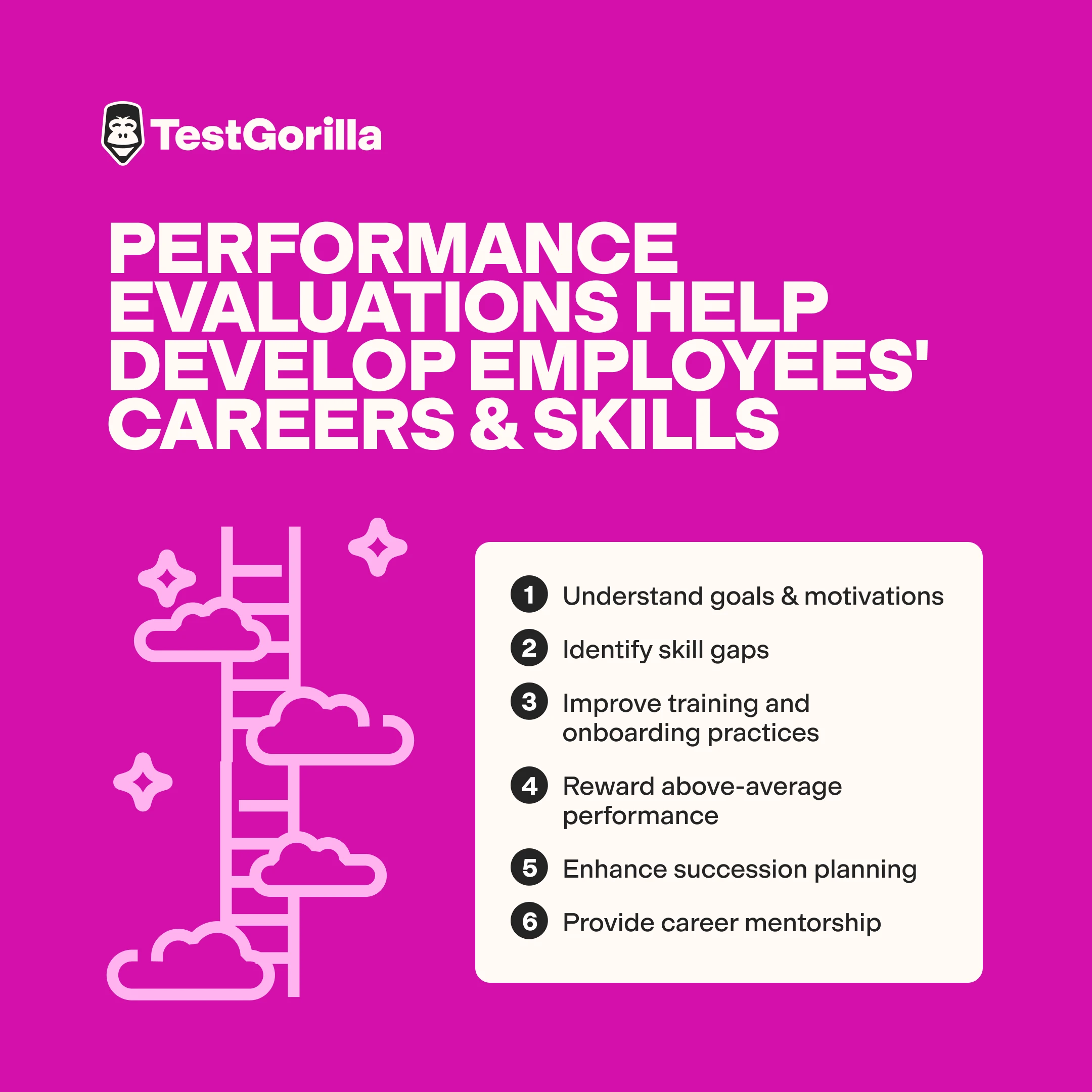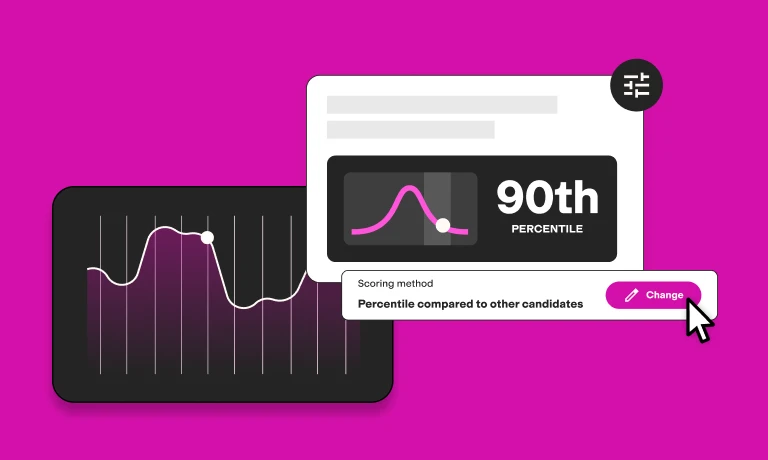What is a performance evaluation?
A performance evaluation, also called a performance appraisal or a performance review, is the process through which you determine your employees' achievements, potential, skill gaps, and future performance goals. Ideally, it's a standardized system across your workforce with minimal bias, taking place quarterly, twice annually, or yearly.
Performance evaluations can take many forms. For instance, they may take place over an online or face-to-face meeting, in multiple-choice evaluation forms, or in evaluation letters. Comprehensive reviews are often structured into:
Self-appraisal by the employee
Evaluation by the evaluator (for instance, a manager), who discusses performance metrics – such as productivity level, achievements, and shortcomings
Feedback from the evaluator on the employee’s skills and behaviors
Determination of outcomes, such as raises, promotions, training, and future goals
The role of performance evaluations in employee development
Here's how performance evaluations help you develop your employees' careers and skill sets.
Understand goals and motivations: Performance appraisals enable employees to open up about short- and long-term career goals and motivators. You can use these insights to adjust performance management metrics and managerial support.
Identify skill gaps: Analyzing past challenges and future targets helps you pinpoint individual skill gaps.
Improve training and onboarding practices: Cross-company evaluations could point to gaps in training and onboarding practices. For example, if various employees score low in critical thinking, you can take steps to improve training in this area.
Reward above-average performance: Rewards for strong performance – including raises, promotions, and acknowledgement – can help you motivate and retain top employees.
Enhance succession planning: Consistent performance reviews enable you to spot and nurture employees with leadership potential.
Provide career mentorship: You can spotlight opportunities for more structured career mentorship by understanding your employees’ aspirations and challenges.
Types of performance evaluation methods
There are multiple ways to conduct performance evaluations. Pick those that best serve your workforce and budget.
Here's what to consider.
Evaluation method | Definition | Example | Pro | Con |
Self-evaluation | Employees assess their own performance, including strengths and improvement areas | Instructions for employee: “Score yourself on 10 skills and traits, and write a 100-word self-evaluation” | Promotes accountability and self-awareness | Requires other methods to reduce evaluation bias |
Checklist | Evaluators mark behaviors or achievements from a predefined list | A checklist contains specific scenarios under categories like "Teamwork" or "Sales targets" You mark these using performance ratings (e.g. 1-5 scale) or forced choice options (e.g., "communicates clearly" vs. "avoids communication") | Is easy to standardize across roles and teams | Doesn't allow qualitative examples and opinions |
Multiple stakeholders provide evaluations, including managers, clients, and coworkers | Coworkers give performance ratings, clients provide forced choice answers, and managers write detailed evaluation letters based on roles' primary responsibilities | Provides holistic evaluation, especially for external-facing roles | Is complex to execute and analyze | |
Management by objectives | Managers set and evaluate employees' objectives and key results (OKR) | A sales executive aims to generate $100,000 in a year | Is easy to measure and evaluate without bias. | Reveals little about strengths and challenges |
Competency assessment | Employees take standardized tests on job-specific competencies | A customer support assistant completes a skills assessment on customer service, communication, and attention to detail | Measures skill and ability level accurately | Doesn't track on-the-job performance or achievements |
Critical incident | Evaluators identify specific events that positively or negatively impacted an employee's performance | A manager marks “Winning a lucrative contract” as the employee's top yearly achievement | Provides performance context, including personal strengths | Must be paired with measurable metrics to reduce bias |
The best insights on HR and recruitment, delivered to your inbox.
Biweekly updates. No spam. Unsubscribe any time.
How to prepare for a performance evaluation
Complete these three steps before conducting your performance evaluations – whether by form, letter, or in meetings.
1. Define your performance evaluation framework
A performance evaluation framework tells you:
What you're evaluating
How you're making evaluation decisions
Which practical outcomes result from evaluations
You can tailor your evaluation framework to different departments, roles, and seniority levels.
For example, creative and administrative role evaluations (e.g., graphic design, personal assistant) may be more checklist and self-evaluation-heavy than numerical jobs (e.g., sales, accounting), which are easily tied to measurable OKRs. Similarly, you may prioritize 360-feedback for senior roles where stakeholder relationships are vital for good performance.
Here's an example evaluation framework for a software development team.
Evaluate developers on coding skills, teamwork, and time management.
Use management by objectives and checklist methods.
Provide extra mentorship and training to those who score 0-49%, and give those who score 70-100% a 10% raise.
2. Measure key performance indicators
Key performance indicators (KPIs) are job-specific metrics that help remove subjectivity from performance evaluations. You can track them over time, which is especially helpful for determining long-tenured employees' readiness for promotion and leadership positions.
First, set performance goals that balance business goals with employees' skills and resources. For instance, a junior recruiter's KPIs might include making three hires in under 60 days. Identify realistic targets by checking past metrics across your team, industry averages, and your business growth goals.
Then, implement a system to track your team's KPIs between employee performance reviews. For example, you might use an applicant tracking system's analytics feature to measure the KPIs of the recruiter mentioned above.
3. Check relevant materials
Don’t rely solely on KPIs – check relevant documentation for other performance-related info. For example, review performance evaluation notes from previous years, project documents, and HR records such as incident reports or complaints.
Best practices for giving constructive feedback
High-quality constructive feedback is clear, balanced, specific, future-focused, and motivational. Here’s how to give it:
Highlight behaviors, not traits
Focusing on behaviors – actions or dos and don'ts – takes the personal out of the equation. Your employees feel less threatened and insecure. Here’s an example:
Behavior-focused: "In that situation, the lead declined to have a call because the cold emails sounded too generic. Next time, try speaking as you would to a friend."
Traits-focused: "You're too salesy. Be more authentic."
Make it a two-way sandwich
The traditional feedback sandwich places a negative statement between two positive ones. However, this one-sided feedback method may not translate well across cultures – and could over-inflate the negative feedback.
If your performance review directly involves the employee (e.g., in takes place in real time), use the modified two-way sandwich:
Let the employee give themselves positive feedback, perhaps aided by a prompt like, "What do you think went well for you in email marketing?" Then, add your own examples of strengths and achievements. Be specific – for instance, mention a % sales increase or which client they impressed.
Provide improvement recommendations, framed around business needs and processes. For instance, say, "Publishing communications at strategic times strengthens our sales efforts" rather than "You should improve your social media knowledge." Ask follow-up questions, such as, "What are your thoughts?"
End on an uplifting note. For instance, express trust in the employee's abilities or ask them which type of support they need.
If your performance review doesn’t directly involve the employee (e.g., if it’s a written eval), consider finding a way to involve them – for instance, by asking for a written self-appraisal beforehand or follow-up feedback after.
Don't stop at the performance review
Offer "fast feedback" – ongoing feedback offered soon after an event or achievement – to reinforce employees' evaluation improvement points. One study found that 8 in 10 employees who received valuable and recent feedback feel fully engaged.
For example, if active listening is an evaluation improvement point, observe when the employee applies it and discuss this in a one-on-one.
FAQs
How do you evaluate performance (with examples)?
You evaluate performance by checking and discussing employees' behaviors and achievements across key job areas. For example, in a customer service assistant evaluation, you might look at case resolution metrics, problem solving ability, and communication.
What are the 5 levels of performance evaluation?
The five levels of performance evaluation are:
Outstanding
Exceeds expectation
Meets expectation
Needs improvement
Unsatisfactory
Evaluators assign scores to specific skills or behaviors.
You've scrolled this far
Why not try TestGorilla for free, and see what happens when you put skills first.



















